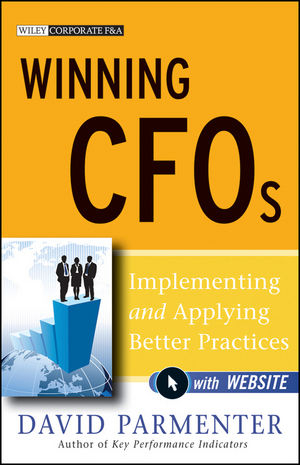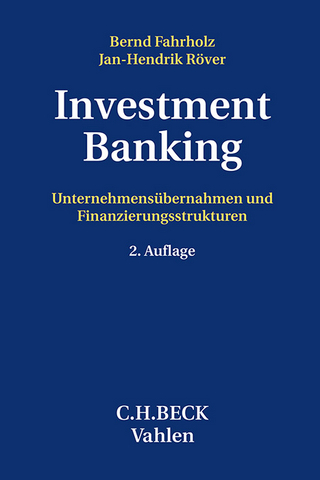
Winning CFOs
John Wiley & Sons Ltd (Verlag)
978-0-470-76750-4 (ISBN)
- Titel erscheint in neuer Auflage
- Artikel merken
Better practices that today's CFOs can employ to bring value and efficiency to the teams that report to them Helping corporate accountants from the CFOs to the management accountant implement better practices that will make a difference to their finance team's performance, Winning CFOs shows corporate accountants how to create permanent improvements in their organization's processes. * Provides better practice solutions the author has learned from more than 4,000 finance teams worldwide * A to Z guidance on how to be an effective CFO * Includes templates, checklists and implementation programs for process improvement * Abundance of tools to ensure implementation of better practices * Tips on how to develop winning leadership traits Winning CFOs shows corporate accountants how to radically transform their contribution to their organization, enhance their job satisfaction and profile, and leave a legacy of efficiency and effectiveness in every organization for which they work.
DAVID PARMENTER is an international presenter who is known for his thought-provoking and lively sessions, which have led to substantial change in many organizations. He is a leading expert in the development of winning KPIs, replacing the annual planning process with quarterly rolling planning, management and leadership practices that will get you to the top, and corporate accounting best practice. David has delivered workshops to thousands of attendees in many cities around the world including Sydney, Melbourne, Kuala Lumpur, Singapore, Tehran, Johannesburg, Rome, Dublin, London, Manchester, Edinburgh, and Prague. David has worked for Ernst & Young, BP Oil Ltd, Arthur Andersen, and PricewaterhouseCoopers, and is a fellow of the Institute of Chartered Accountants in England and Wales. He is a regular writer for professional and business journals. He is also the author of Key Performance Indicators: Developing, Implementing, and Using Winning KPIs, Pareto's 80/20 Rule for Corporate Accountants, and The Leading-Edge Manager's Guide to Success: Strategies and Better Practices, all published by Wiley. David Parmenter can be contacted via parmenter@waymark.co.nz or +64 4 499 0007. His website www.davidparmenter.com contains many white papers, articles, and freeware that will be useful to the reader.
Acknowledgments xv Introduction xvii PART I AREAS TO FOCUS ON IN THE NEXT SIX MONTHS 1 CHAPTER 1 Accounts Payable in the 21st Century 3 Removal of Charles Dickens s Processes 3 Move to a Paperless Accounts Payable Function 4 Invest in an Electronic Ordering System (Procurement System) 4 Introduce a Purchase Card 5 Cut Off Accounts Payable on the Last Working Day 6 Close Accruals a Day before the Accounts Payable Ledger 7 Limit the Accruals 7 Mount the Last Signed Check on the CEO s Wall 8 Perform Frequent Direct Credit Payment Runs 8 Improve Budget Holders Cooperation 9 Speed Up Budget Holders Correction of Omissions 9 A Welcome Letter to All New Budget Holders 9 Introduce Shame and Name Lists 10 Reward Good Budget Holder Behavior 11 Have a Closer Relationship with Your Main Suppliers 11 Use Self-Generated Invoices (Buyer-Created Invoices) 12 Note 12 CHAPTER 2 Timely Month-End Reporting: By Working Day 3 or Less 13 Rating Scale for Month-End Reporting 14 Benefits of Quick Month-End Reporting 14 Impact of a Quick Month-End on the Finance Team Workload 15 Major Steps You Can Do Next 16 Major Steps You Can Do within the Next Six Months 23 History of Quick Month-End Reporting 26 Research on Quick Month-Ends 30 Implementing Quick Month-End Reporting 30 Some Tips on Running a Post-it Reengineering Session 35 Selling the Need for Quick Month-End Reporting 36 Key Month-End Activities on a Day 3 Month-End 37 Notes 38 CHAPTER 3 Make the Monthly Reports Worth Reading 39 Foundation Stones on Month-End Reporting 39 Reporting a Business Unit s Performance 40 Reporting a Consolidated Profi t and Loss Account 42 The One-Page Summary to the CEO 43 Reporting the Balance Sheet 43 Reporting a Quarterly Rolling Accrual Forecast 45 Snapshot of All Projects Currently Started 47 Reporting Progress of the Top 10 Projects 49 Cash Flow Forecasting 50 CAPEX Reporting 54 The One-Page Investment Proposal 54 Reporting the Strategic Objectives/Risks/Cost Pressures 56 Designing Graphs and Dashboards 60 Notes 61 CHAPTER 4 Limit the Time Invested in Board Reporting 63 Selling Change to the Board 63 Costing the Preparation of Board Papers 64 Scoping of the Information Requests 64 Avoiding Rewrites of Board Reports 65 Tabling Board Papers Electronically 65 More Timely Board Meetings 66 Board Meeting Less Frequently than Once a Month 66 Continually Purging the Board Papers 66 Timeliness of Board Meetings 67 Reporting Key Result Indicators in a Dashboard to the Board 67 Examples of Key Result Indicators for a Board Dashboard 70 Notes 73 CHAPTER 5 Timely Annual Planning Process: Ten Working Days or Less! 75 Sell the Change through Emotional Drivers 75 Foundation Stones of an Annual Planning Process 76 Efficient Annual Planning Processes 80 Note 90 CHAPTER 6 Managing the Accounting Team 91 Hold an Off-Site Meeting for the Accounting Team at Least Twice a Year 91 Set Up Monthly One-on-One Progress Meetings with Your Direct Reports 93 Become Known for Giving Recognition Freely 93 Attract the Best Staff to the Team 94 Adopt Better Recruitment Practices 95 Recognize Staff Performance 96 Team Balanced Scorecards 96 Better Practice Training 96 Outdoor Pursuit Adventure 98 Team-Building Lessons from a World-Class Coach 98 CFOs and All Direct Reports Must Find a Mentor Immediately 98 Become a Serving Leader 99 Five Foundation Stones of a Serving-Leader 100 Areas of Focus for a Serving-Leader 104 A Viking with a Mother s Heart 111 Three-Month Planner 115 Notes 115 CHAPTER 7 Quick Annual Reporting: Within 15 Working Days Post Year-End 117 Costs of a Slow Year-End 117 Cost the Annual Accounts Process 118 A Quick Year-End Is a Good Year-End 118 Help Get the Auditors Organized 120 Appoint an Audit Coordinator 120 Complete the Drafting of the Annual Report before Year-End 121 Limit when Changes Can Be Made 121 Negotiate and Plan for a Sign-off by the Auditors within 15 Working Days 121 Have a Month 10 or 11 Hard Close 122 Effective Stock Takes 123 Estimating Added Value in Work in Progress and Finished Goods 123 Effective Fixed Asset Verification 123 Importance of the Internal Auditors 124 Extract More Value from the Management Letter 124 Derive More Value from the Interim Audit 125 Run a Workshop to Post-it Reengineer Year-End Reporting 125 Restrict Access to Confidential Information to the Audit Partner 128 Speeding Up the Reporting Supply Chain 128 Moving Forward 129 Some Case Studies 130 Notes 131 CHAPTER 8 Managing Your Accounts Receivable 133 Operational Improvements to Accounts Receivable 133 Reporting on Your Accounts Receivable 134 Avoiding Accounts Receivable Month-End Processing Bottlenecks 134 Increasing the Use of Direct Debiting of Customers Accounts 135 Debtors Collection before Year-End 136 CHAPTER 9 Marketing the Accounting Team 137 Fitting into the Wider Team 138 CHAPTER 10 Client Management: Improving Relationships with Budget Holders 141 Perform an In-House Customer Satisfaction Survey 141 CHAPTER 11 More Emphasis on Daily and Weekly Reporting 145 Yesterday s Sales Report 146 Weekly Key Customers Sales 146 Weekly Reporting on Late Projects and Late Reports 148 CHAPTER 12 Working Smarter, Not Harder 151 Staff Debriefi ng at the End of the Day 151 Banning Morning Meetings for the Finance Team 152 Implementing Action Meetings Methods 153 Golden Rules with Emails 154 Continuous Innovation in the Finance Team 157 Getting the Induction Process Right 157 Creating a Service Culture in the Finance Team 158 Having Fun in the Workplace 158 CHAPTER 13 Limit the P&L to 50 Account Codes 161 Project Accounting 162 Subsidiary Chart of Accounts 162 Note 162 PART II AREAS TO FOCUS ON ONCE CORE GAINS HAVE BEEN ACHIEVED 163 CHAPTER 14 Throw Out Annual Planning and the Associated Monthly Budget Cycle 165 Reporting without a Budget 167 Note 168 CHAPTER 15 Quarterly Rolling Planning: An Evolvement from Quarterly Rolling Forecasting 169 Quarterly Rolling Forecasting Is the Most Important Management Tool of This Decade 169 Ten Foundation Stones of a Rolling Forecasting Process 171 Better Practices in a QRF 184 Implementing a Quarterly Rolling Forecasting and Planning Process 186 Note 192 CHAPTER 16 Cost Apportionment: Do Not Do It Monthly! 193 CHAPTER 17 Ban Excel from Core Monthly Routines 195 Note 196 CHAPTER 18 Identifying the Organization s Critical Success Factors 197 Benefits of Understanding Your Organization s Critical Success Factors 198 An Airline CSF 199 Relationship among CSFs, Strategy, and KPIs 199 Finding Your Organization s CSFs 201 Notes 202 CHAPTER 19 Reporting Your Winning Key Performance Indicators 203 The 10/80/10 Rule 204 Key Result Indicators 204 Performance and Result Indicators 205 Key Performance Indicators 205 Characteristics of a KPI 207 Importance of Daily CEO Follow-up 209 Selling KPIs through the Emotional Drivers 209 Reporting KPIs 24/7 or Daily to Management 210 Reporting Weekly KPIs and PIs to Management 210 Reporting Monthly PIs and RIs to Management 210 Reporting the Key Result Indicators in a Dashboard to the Board 213 Reporting to Staff: The Team s Progress 213 Reporting to Staff: The Organization s Progress 213 12-Step Model for Implementing Performance Measures 213 How KPIs and Financial Reporting Fit Together 219 Notes 222 CHAPTER 20 Where to Invest in Your Accounting Systems for Maximum Benefit 223 Avoiding the Hard Sell 223 Better Systems to Invest in 224 Note 227 CHAPTER 21 Implementing a New Accounting System 229 CHAPTER 22 Better Use of the Intranet 233 Your Intranet Should Be a Spider s Web 233 The Intranet as a Business Tool 234 What the Finance Team Can Do 235 PART III AREAS WHERE COSTLY MISTAKES CAN BE MADE 237 CHAPTER 23 Designing Performance Bonus Schemes 239 Foundation Stones 239 Avoid Having Deferral Provisions 245 Note 250 CHAPTER 24 Avoiding a Rotten Takeover or Merger 251 How Takeover or Merger Goes Wrong 251 Takeover or Merger Scorecard 255 Alternatives to a TOM 255 Note 259 CHAPTER 25 Hidden Costs of Downsizing 261 CHAPTER 26 A Reorganization Too Many 265 Ramifications and Associated Costs 265 An Addiction to Reorganizations 266 Typical Reasons for a Reorganization 266 There Are Alternatives to a Major Reorganization 268 Before You Look at a Reorganization 271 Note 272 CHAPTER 27 Listing on the Stock Exchange 273 Gather Useful Experiences 273 Selecting the Advisors 274 Have a Well-Oiled Public Relations Machine 274 The Prospectus 275 Due Diligence Coordinator 275 Preparing the Forecast 276 Getting the Timing Right 276 Sources of Useful Information 277 Notes 277 CHAPTER 28 Managing the Treasury 279 An Open and Honest Relationship with Your Banks Will Pay Off 279 Do Not Get into Deals You Do Not Understand 280 You Can Never Guess the Future, So Be Half Right and Half Wrong 280 Foreign Exchange Trading Can Be a Zero-Sum Game 281 Obtaining Credit Lines When You Do Not Need Them 281 Staggering the Maturity of Loans 281 Sources of Useful Information 283 Appendix A Checklist of Areas to Focus on in the Next Six Months 285 Appendix B Month-End Reporting Checklist 293 Appendix C Month-End Bottlenecks and Techniques to Get around Them 297 Appendix D Speeding Up the Annual Audit Process Checklist 301 Appendix E Checklist of Strategic Focus Areas 307 Appendix F How a Quarterly Rolling Forecast Can Be Laid Out in a Planning Tool 311 Appendix G Implementing a Quarterly Rolling Forecast Checklist 315 Appendix H Performing a Quarterly Rolling Forecast Checklist 321 Appendix I Streamlining an Annual Planning Process Checklist 325 Appendix J Useful Letters and Memos 329 Appendix K A Satisfaction Survey for an Accounting Function 339 Index 347
| Reihe/Serie | Wiley Corporate F&A |
|---|---|
| Zusatzinfo | Illustrations |
| Verlagsort | Chichester |
| Sprache | englisch |
| Maße | 162 x 230 mm |
| Gewicht | 608 g |
| Themenwelt | Wirtschaft ► Betriebswirtschaft / Management ► Finanzierung |
| ISBN-10 | 0-470-76750-2 / 0470767502 |
| ISBN-13 | 978-0-470-76750-4 / 9780470767504 |
| Zustand | Neuware |
| Haben Sie eine Frage zum Produkt? |
aus dem Bereich



